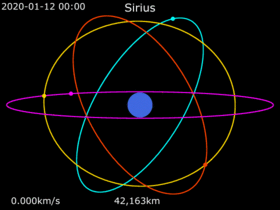Engineering:Sirius FM-1
From HandWiki
| Mission type | Communication |
|---|---|
| Operator | Sirius Sirius XM Radio |
| COSPAR ID | 2000-035A |
| Mission duration | Planned: 15 years; Achieved: 15-16 years |
| Spacecraft properties | |
| Bus | LS-1300 |
| Manufacturer | Loral |
| Launch mass | 3,800 kilograms (8,400 lb) |
| Start of mission | |
| Launch date | 30 June 2000 |
| Rocket | Proton-K/DM3 |
| Launch site | Baikonur 81/24 |
| Contractor | ILS |
| End of mission | |
| Disposal | Disposal orbit |
| Deactivated | 2016 |
| Orbital parameters | |
| Reference system | Geocentric |
| Regime | Tundra |
CD Radio 1, also known as Radiosat 1, was an American communications satellite which was operated by Sirius XM Radio, previously Sirius Satellite Radio. It was constructed by Space Systems Loral and was based on the LS-1300 satellite bus. Launch occurred on 30 June 2000, at 22:08 GMT. The launch was contracted by International Launch Services, and used a LV Proton K rocket flying from military pad Site 81/24 at the military polygon Baikonur Cosmodrome.
It was operating in a HEO, from where it provided satellite radio communications services to all Earth (global). It had an expected planned money lifetime of 15 years.
In 2016, the satellite was decommissioned and placed into a disposal orbit.[1]
Animation of Sirius's orbit
See also
- Sirius FM-2
- Sirius FM-3
- Sirius FM-5
References
- ↑ Meyer, James E.; Frear, David J., eds (2 February 2017). Sirius XM Holdings Inc. 10-K Feb. 2, 2017 11:57 AM (Report). Sirius XM Holdings Inc.. https://seekingalpha.com/filing/3381845.
- Krebs, Gunter. "Sirius FM1, FM2, FM3, FM4 (Radiosat 1, 2, 3, 4)". Gunter's Space Page. http://space.skyrocket.de/doc_sdat/sirius-cdr.htm. Retrieved 2009-05-02.
- McDowell, Jonathan (2000-07-04). "Issue 429". Jonathan's Space Report. http://planet4589.org/space/jsr/back/news.429. Retrieved 2009-05-02.
 |




